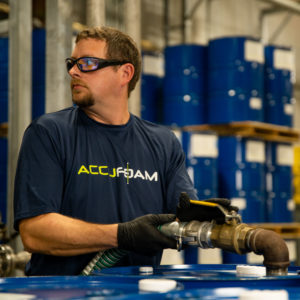
To say the last year and a half has been difficult would be putting it quite mildly. From families to businesses, everyone experienced hardships in many different ways throughout the coronavirus pandemic. However, as the number of vaccinated individuals rises and the number of cases decreases, the world is slowly but surely returning back to normal.
While the worst of the coronavirus might be behind us, there are lingering effects that will continue to impact these very same families and businesses, particularly the raw material shortage crisis that the world is facing.
Over the past year, many industries have been unable to secure the necessary supply of many of the raw materials they rely on to produce goods and services, making projects harder to complete. Accufoam®, and the rest of the insulation industry, have certainly not been exempt from having to navigate these difficult conditions.
How did this insulation shortage happen and how does it affect you, you might be asking? Let’s take a closer look at the perfect storm that occurred to create this raw material shortage and how Accufoam® has made it our mission to combat the crisis.
What caused the insulation material shortage crisis?
There is not one singular cause of the current material crisis. Rather, a multitude of factors combined to create the situation. There was one event, however, that kick-started it all.
Coronavirus
During the height of the global pandemic, businesses, factories, and manufacturers all across the world had to make adjustments. In some cases that meant limiting the number of workers allowed on production lines or significant employee layoffs. For many other businesses, that meant sending employees home and shutting down production entirely.
This began the start of a Domino Effect. During this shutdown period, limited operations meant fewer materials were processed and shipped. Longer shipping times and fewer shipments of these materials caused fewer products being produced by manufacturers.
In some cases this trend wasn’t too troublesome, as buyer demand for certain products decreased during the pandemic as well. However, there were some industries that did not see a decrease in demand. As a matter of fact, demand increased!
Home improvement projects
As soon as lockdown orders began to come down, the reality of being stuck at home for the foreseeable future started weighing on folks. So, many decided to make the most of their time spent at home and started investing in home improvement projects.
These home improvement projects caused a surge in construction-related product orders and purchases on things like lumber, siding, and insulation. Quickly chewing through available stockpiles, this surge in products only worsened the already tough situation and soon created an environment with very little available inventory and slow production unable to keep up with demand.
Economic recovery
Thankfully we are now in a time and place where things are returning to normal and the economy is recovering. However, pent-up demand on certain products has returned and those facilities that had to scale back production, lay off large numbers of employees, or close their doors now find themselves unable to keep up with the returned demand.
That brings us to today. The combination of staff shortages, the using up of much of the available inventory, limited production over the past year and a half, and a sudden skyrocketing of demand has created where construction materials, including insulation products, are harder to come by resulting in delayed shipping and increased prices.
Insulation shortages are not new
While we certainly didn’t expect this kind of shortage to hit the insulation industry so abruptly, high demand for insulation is not a new development. The demand for polyurethane has grown significantly each year over the past decade and is forecasted to continue to grow in the years to come.
In fact, between 2014 and 2016, demand for polyurethane grew around 4.4% per year. From 2016 and 2018 is continuing at that level or higher. Over this time, the production of polyurethane has increased by as much as 4.4% to compensate. So, as you can see, in the years leading up to the coronavirus, the industry was already working to meet increased demand, and will continue to do so during this recovery period.
What has Accufoam® done about the insulation material crisis?
Because of our preparation in the years leading up to the coronavirus and following material shortage, Accufoam® is proud to say that our adaptation skills have made it easier to maintain the best relationship possible with our clients and deliver the insulation products they need as soon as possible. The most important thing we have learned during this time is that open and honest communication is key.
We understand that shipping delays for important products like insulation can significantly delay construction projects delays. That is why we are always up-front and honest with our distributors, giving them realistic timelines and expectations for when they will be receiving their products. That way they can better inform and prepare their customers, who can then place their orders and plan their projects accordingly.
Despite delays and shortages, Accufoam® strives to continue to provide industry-leading insulation materials, including our ultra-low and medium density spray foam, on a timely and transparent schedule to help guarantee the best possible quality, results, and keep your projects on track.
Interested in becoming an Accufoam® distributor or getting Accufoam® products delivered to your preferred distributor? Contact us to learn more and you can guarantee that we’ll be open, honest, and transparent during every step of the way.


